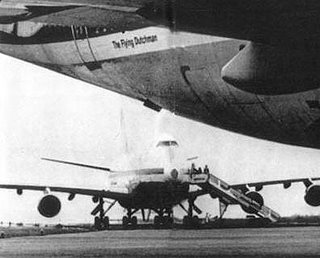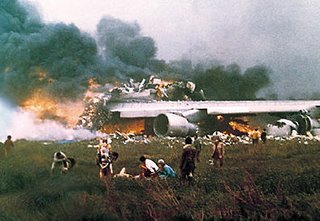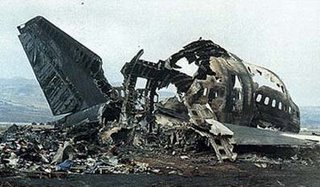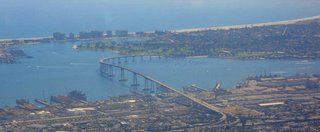DEMAND DISSENT!
How the lack of dissent helped to kill 583 people in the world’s worst air disaster.
The Tenerife disaster took place at 17:06 local time on
March 27,
1977, when two
Boeing 747 airliners collided at
Los Rodeos Airport on the island of
Tenerife,
Canary Islands, killing 583 people. The accident resulted in the highest
death toll of any accident in aviation history.
Background:Spain's Canary Islands are situated 250 nautical miles off the Moroccan coast of North Africa.
They have, for many years, been a popular tourist attraction for people wanting the best of weather any time of the year. Ancient Greek and Roman seafarers knew them as the "Fortunates Isles." Tenerife, then and now, is served mainly by the airport in the south of the island, known as Reina Sofia, but years ago the Island was served by the airport up in the north of the island, known as Los Rodeos.
Los Rodeos is still used today, but mainly only for domestic flights around the islands, or for cargo flights. There is still a pall hanging over this airport.
The events leading up to the Tenerife Disaster started on the Island of Las Palmas, which is also part of the Canary Islands.
When It Began:
Sunday March 27, 1977 should have been no different than any other spring day at Las Palmas Airport, with the usual flights operating from all over Europe and the Atlantic. But at 1:15 that afternoon, the passenger terminal was thrown in to chaos and panic after a small bomb planted by a terrorist exploded in a florist's shop in the terminal concourse.
The authorities were warned of this fifteen minutes prior, so although the bomb caused much damage to the building, no one was killed. 8 people, however, were injured, one seriously.
Telephoning the Spanish airport administration afterwards, a spokesman for a militant Canary Islands independence group, speaking from Algeria in north Africa, claimed responsibility for the explosion and hinted that a second bomb was planted somewhere in the airport. On hearing this, the local police had no option but to close the airport and not to take any further chances, pending a thorough search for the second device.
All international incoming flights were then diverted to Tenerife's Los Rodeos Airport, which was less than one hour of flying time away.
The First Plane: KLM Boeing 747-206B PH-BUF Rijn (Rhine River):
Among the flights to be diverted was a charter trip flown by KLM's Boeing 747, PH-BUF.
Operated by KLM as Flight KL4805 on behalf of the Holland International Travel Group, it had departed Amsterdam's Schiphol Airport that morning at 9:31 a.m. local time, carrying 234 passengers escaping the harsh cold winters of Northern Europe for the sunny climates of the Canary Islands. They included 3 babies and 48 children.
Most were Dutch, but there were also two Australians, four Germans, and two Americans on the flight.
In command of 4805 was Captain Jacob Veldhuyzen van Zanten, KLM's chief training Captain for Boeing 747s.
Van Zanten had been flying since 1947, and had been a pilot with KLM since 1951, when as a 24 year old, he commenced duty as a first officer on the company DC-3s. He now had nearly 12,000 hours experience, with more than 1500 hours on the Boeing 747. Most of his time, however, was spent in simulators training other pilots.
After its four-hour trip from Amsterdam, across Belguim, France and Spain, PH-BUF touched down at Los Rodeos Airport at 1340 hrs GMT (1:10 p.m .local time). The fabled Canary Islands failed to live up to its reputation for fine weather, as those on board the KLM 747 were greeted with the sight of low cloud sand light rain, and light fog looming over the airport in the distance.
The apron area, together with a section of the taxiway, was already occupied by diverted aircraft, so on landing, the controller directed the 747 to vacate the runway via the last intersecting taxiway and to park their aircraft on the holding area next to a Norwegian Boeing 737.
Shortly afterwards a DanAir 727 and a Sata DC-8 landed and were both directed to park in the same area.
The Second Plane: Pan American Boeing 747-121 N736PA (Clipper Victor):
At 1:45 pm local time (a little more than a half hour after the arrival of PH-BUF) the Pan American 747 landed and taxied to the same holding area, parking directly behind the KLM 747. N736PA, flight number PA 736 had orginated in Los Angeles, where 364 passengers, most of them of retirement age, had boarded "Clipper Victor" for the first stage of a charter flight to Gran Canaria. Here they would join the Royal Cruise Line's ship "Golden Odyssey" for a twelve day Mediterannean Highlights cruise.
Departing LAX late the previous afternoon, they had flown direct to Kennedy Airport in New York. The aircraft was refueled, 14 additional passengers boarded, and there was a change of crew. After 90 minutes on the ground, the aircraft took off for Las Palmas. On approaching the Canaries six hours later the crew were informed of the temporary closure of the airport and diverted to Tenerife's Los Rodeos airport.
This was unwelcome news to the crew, who had already been on duty for eight hours.
The diversion would just add more hours to the trip, and there were also the passengers to consider - most of them had aleady been on the aircraft for 13 hours as it was. Many were tired and the majority of them were no longer young, so it was taking a greater toll on them. The Pan Am Captain, Victor Grubbs, a 57 year old, 21,000 hour pilot, sensed from the Spanish air traffic controller's instructions that Las Palmas was expecting to reopen before long and, knowing that his aircraft had more than adequate fuel reserves, asked to possibly be put in a holding pattern until it did open. His requests were denied and therefore N736PA had to land and join the rest of the waiting aircraft on the ground at Los Rodeos.
By the time the two aircraft were ready to depart the weather had deteriorated somewhat, due to the fact that there was a good deal of thick fog descending on to the airport.
At first the KLM passengers were not allowed to leave the aircraft, but after about twenty minutes they were all transported to the terminal building by bus. On alighting from the bus, they received cards identifying them as passengers in transit on Flight KL4805. Later, all the passengers boarded KLM 4805 except the H.I.N.T. Company guide, who remained in Tenerife.
The Pan Am passengers stayed on their aircraft the whole time it was on the ground, the doors opened only for them to get some fresh air and to take some photographs of what scenery they could see from the aircraft.
When Las Palmas Airport was opened to traffic once more, the PA1736 crew prepared to proceed to Las Palmas, which was the flight's planned destination.
When they attempted to taxi on the taxiway leading to runway 12, where they had been parked with four other aircraft on account of the congestion caused by the number of flights diverted to Tenerife, they discovered that it was blocked by KLM Boeing 747, Flight 4805, which was located between PA 1736 and the entrance to the active runway. The First Officer and the Flight Engineer left the aircraft and measured the clearance left by the KLM aircraft, reaching the conclusion that it was insufficient to allow PA1736 to pass by, obliging them to wait until the former had started to taxi. Taking this kind of precaution is little known amongst air crews, yet they did it nevertheless.
KLM 4805 called the tower at 16:56 requesting permission to taxi. It was authorized to do so and at 16:58 requested to backtrack on runway 12 for takeoff on runway 30. The tower controller first cleared the KLM flight to taxi to the holding point for runway 30 by taxiing down the main runway and leaving it by the (third) taxiway to its left. KLM 4805 acknowledged receipt of this message from the tower, stating that it was at that moment taxiing on the runway, which it would leave by the first taxiway in order to proceed to the approach end of runway 30.
The tower controller immediately issued an amended clearance, instructing it to continue to taxi to the end of the runway, where it should proceed to backtrack.
The KLM flight confirmed that it had received the message, that it would backtrack, and that it was taxiing down the main runway. The tower signalled its approval, whereupon KLM 4805 immediately asked the tower again if what they had asked it to do was to turn left on taxiway one.
The tower replied in the negative and repeated that it should continue on to the end of the runway and then backtrack.
Finally, at 16:59, KLM 4805 replied, "O.K., sir."
At 17:02, the PA aircraft called the tower to request confirmation that it should taxi down the runway. The tower controller confirmed this, also adding that they should leave the runway by the third taxiway to their left.
At 17:03:00, in reply to the tower controller's query to KLM 4805 as to how many runway exits they had passed, the latter confirmed that at that moment they were passing by taxiway C-4.
The tower controller told KLM 4805, "O.K., at the end of the runway make one eighty and report ready for ATC clearance."
In response to a query from KLM 4805, the tower controller advised both aircraft that the runway centerline lights were out of service. The controller also reiterated to PA1736 that they were to leave the main runway via the third taxiway to their left and that they should report leaving the runway.
THE FIRST CLUE:
As the Pan American aircraft approached its turnoff in the thick fog, the First Officer noticed the landing lights of the KLM aircraft looming through the fog. At first, they appeared stationary, but as several seconds passed, it became obvious that they were shaking.
First Officer Bragg yelled to the Captain "Get off, get off!" at which point full power was applied and the Captain turned the aircraft left towards the grass.
Captain van Zanten on the KLM aircraft desperately tried to rotate and climb out before the Pan Am aircraft, as was evidenced by a 3-foot deep gash in the runway from the aircraft's tail.
The KLM aircraft collided with the Pan Am airplane just after liftoff, and proceeded to climb to approximately 100 feet before losing control and crashing. The Pan Am aircraft immediately burst into flames and broke into several pieces.
There were no eyewitnesses to the collision.
Place of accident:
The accident took place on the runway of Tenerife Airport (Los Rodeos) at latitude 28° 28' 30" N and longitude 16° 19' 50" W. The field elevation is 2,073 feet (632 m).
Injuries and Fatalities to persons aboard KLM4805:
None of the 234 passengers and 14 crew survived the accident.
Damage to KLM Boeing 747 PH-BUF:
The aircraft lifted off briefly before the collision with the Pan Am aircraft, but due to severe damage caused on impact, fell back to the runway 250 yards after impact. The aircraft was totally destroyed by fire.
Injuries and Fatalities to persons aboard PA1736:
Of the 16 crew on board, there were 9 fatalities, 7 survivors + 2 company employees who were sitting in the cockpit jump seats. Of the 317 passengers on board, 61 survived the accident ,but 9 died of their injuries at a later date.
Damage to Pan Am Boeing 747 N736PA:
The aircraft was written off in the accident due to the severe impact caused by the KLM aircraft, and the resulting fire. Between 15 and 20 tons of Kerosene was later recovered from the one remaining wing that survived the fire.
Accident Investigation:
There were many questions regarding the cause of this accident:
1. Why had Captain van Zanten commenced take off with out the ATC clearance to do so?
2. Why had Captain Grubbs been instructed to vacate the runway at taxi way?
3. Which would have taken him back towards the main apron, and not T4 which would have put him on the holding point for runway 30?
4. Why did the KLM crew not grasp the significance of the Pan Am aircraft's report that it had not yet cleared the runway, and would report again to the tower when it did?
CONCLUSIONS:
The final accident report found that KLM master pilot Jacob Van Zanten was solely responsible for the accident.
The fundamental factors in the development of the accident were the facts that van Zanten:
-- Took off without being cleared to do so.
-- Did not heed the air traffic controller's instruction to stand by for take off.
-- Did not abandon take off when he knew the Pan Am aircraft was still taxiing.
BUT THERE WAS MORE, LATER REVEALED:
In 1977, there was absolutely no dissent in any commercial airliner's cockpit -- much less that of a Dutch KLM cockpit given that country's history.
The Pilot was at that time akin to a supreme being; Jacob van Zanten was almost beyond that insofar as he had not only been an instructor for 10 years (though spending much of his duty time during those years in the company's simulators) but he was the entire airline's Master Pilot.
However, his predominant simulator time actually reduced his day-to-day familiarity with standard route flying and its concomitant procedures.
Nevertheless, he clearly had high standing in the KLM organization; his Master Pilot status, his instructor status, and his image being plastered around various KLM advertisements in magazines around the world.
HERE WE GO:
The First Officer was a former DC-8 pilot who had only recently moved to the 747 aircrew and started in the co-pilot's seat.
He was now flying with THE Captain who had recently offered his 747 ratings. This played a role in the cockpit relationship.
Think about it:
Here is your company Master Pilot. He is an instructor. You are flying the aircraft of your dreams. He has not only taken and assumed massive responsibility, he was the one who granted your transferral from the lowly DC-8 to the massive 747. As co-pilot you have 96 hours on the beast but you know your Master Pilot is not only in command, he is the "epitome" of command as per your company advertisements.
Despite that, First Officer Meurs said: "Wait, we don't have an ATC clearance," when van Zanten let the massive KLM 747 roll forward on completion of the pre-takeoff checks.
Meurs knew where the KLM 747 was located. He knew the history of this KLM Master Pilot. He knew the beginning takeoff was clearly against orders and let the throttle-up begin nevertheless.
___________________
Any air disaster consists of not one or two events, but a cascading event chain.
Such it was with the Tenerife disaster, when the pilot completely ignored various warnings and the Co-Pilot DIDN'T INSIST, and the culture was not to demand dissent in the cockpit.
The First Officer knew what was wrong, and when it was wrong. Had he spoken and perhaps become strident and insistent, he might have been heard. Subsequently he was not heard and 600 people died.
___________________
This event was responsible for a new training paradigm within the cockpit whereas lesser officers are given the chance to speak their minds with regard to safety and related events and issues.
And the Captains and Master Officers are required to actually listen.
Which merely reinforces what we in SLI have learned: that we must "demand dissent" and create an atmosphere and culture where this concept is nurtured.





